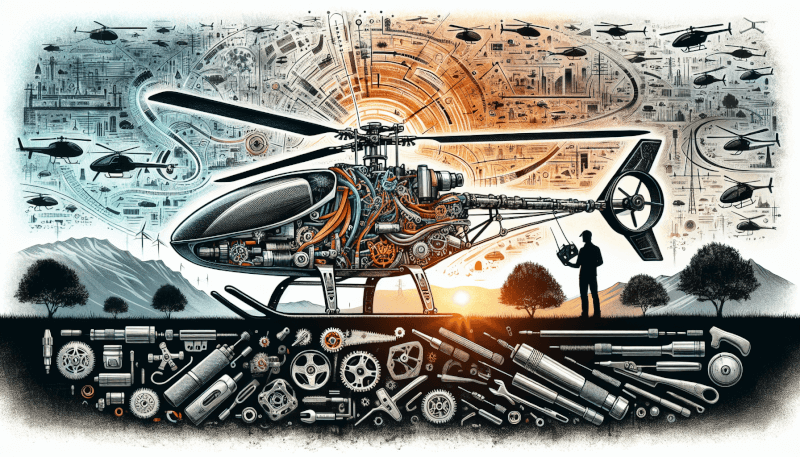If you find yourself fascinated by the world of remote-controlled helicopters, it’s important to remember that along with the excitement comes a responsibility for safety. Whether you’re a seasoned pilot or just starting out, knowing and implementing the essential safety precautions when flying RC helicopters is crucial. From checking your equipment to choosing an appropriate flying location, this article will guide you through the necessary measures to ensure a safe and enjoyable flying experience. So, buckle up and get ready to explore the world of RC helicopter flying with confidence and caution!

Pre-flight Preparations
Before taking off with your RC helicopter, there are a few essential pre-flight preparations that you should always follow. First and foremost, it is crucial to inspect your helicopter thoroughly. Check for any visible damage, loose parts, or malfunctioning components. Make sure that everything is in working order before you take to the skies.
Next, it is essential to check the weather conditions. Flying in unfavorable weather conditions can lead to unpredictable flight behavior and potential accidents. Ensure that the wind speeds are within safe limits and that there are no rain or strong gusts forecasted. Always prioritize safety over the excitement of flying.
Another important consideration for pre-flight preparations is choosing the right flying location. You should select an area that is spacious, clear of any obstacles or obstructions, and far away from any populated areas. This will minimize the chances of collisions and allow you to have better control over your helicopter during flight.
Personal Safety Measures
When it comes to personal safety, there are a few measures that you should follow to keep yourself and others safe while flying your RC helicopter. Firstly, always wear appropriate clothing and protective gear. This includes sturdy shoes, long pants, and a long-sleeved shirt to protect your skin from any potential injuries. Additionally, consider wearing goggles or safety glasses to shield your eyes from debris or rotor wash.
Maintaining a safe distance from the helicopter is also crucial for personal safety. The rotating blades and powerful motors can cause harm if you get too close. Always stand behind and to the side of the helicopter, ensuring there is no chance of accidentally coming into contact with the moving parts.
Another important personal safety measure is to avoid flying your RC helicopter near people or animals. Even though it can be tempting to show off your aerial skills to others, flying near individuals can be risky. The sudden movements or malfunctions can cause accidents or injuries to bystanders. It’s always better to fly in designated areas away from crowds and wildlife.
Battery Safety
Proper battery safety is essential to ensure a smooth and incident-free flight. Firstly, it is crucial to use the correct battery and charger for your RC helicopter. Using incompatible batteries or chargers can lead to overheating, fires, or even explosions. Always follow the manufacturer’s recommendations and guidelines when it comes to battery selection and charging.
Before taking flight, make sure the battery is properly connected to the helicopter. Inspect the connections for any loose wiring or corrosion, and ensure the battery is securely in place. Loose connections can lead to power interruptions, loss of control, or unexpected shutdowns during flight.
When not in use, store your RC helicopter batteries safely. Keep them in a cool, dry place, away from flammable materials or excessive heat. It is also a good practice to remove the batteries from the helicopter when not in use to prevent any accidental discharge or damage.
Propeller Safety
The propellers of an RC helicopter can be dangerous if not handled with caution. To ensure propeller safety, it is important to avoid touching the propellers while the helicopter is powered on. The high-speed rotation of the blades can cause severe injuries if they come into contact with your fingers or any other body part. Always wait for the blades to come to a complete stop before approaching or handling the helicopter.
If you encounter broken or damaged propellers, handle them with caution. Sharp or jagged edges can cause cuts or puncture wounds. Use protective gloves when removing damaged propellers and dispose of them safely. Regularly inspect your propellers for any signs of wear or damage, and replace them immediately if necessary.
An additional propeller safety measure is to keep long hair and loose clothing away from the propellers. Loose items can get caught in the blades, leading to entanglement or accidents. Tie back long hair and wear well-fitting clothing to minimize the risk of such incidents.

Flying Techniques
Learning to fly your RC helicopter properly is vital for a safe and enjoyable experience. Start by practicing in a controlled environment with plenty of space and no obstacles. This will help you get used to the controls and understand the helicopter’s behavior in different flight conditions. Beginner-friendly open fields or empty parking lots are excellent places to hone your flying skills.
Begin with basic maneuvers before attempting advanced ones. Practice hovering, forward and backward flights, and gentle turns. Once you have mastered these basics, you can gradually move on to more complex maneuvers like loops, rolls, and inverted flights. Taking gradual steps will build your confidence and improve your control over the helicopter.
Avoid aggressive flying and sudden movements, especially when you are still learning. Sharp turns or rapid changes in direction can cause instability and even lead to crashes. Instead, focus on smooth and controlled movements, gradually increasing the complexity as you gain more experience. Remember, patience and practice are key when it comes to mastering the art of flying an RC helicopter.
Maintaining Line of Sight
Maintaining a clear line of sight with your RC helicopter is crucial for keeping control and ensuring the safety of your flight. Always keep the helicopter within your visual range to avoid losing orientation or control. Flying too far away or behind obstacles can make it difficult to judge altitude, distance, and direction, increasing the risk of accidents.
It is essential to avoid flying in low light or obstructed areas. Reduced visibility can make it challenging to see the helicopter clearly or to navigate accurately. Choose well-lit areas and avoid flying during dusk, dawn, or at night unless your RC helicopter is equipped with proper lights and you have the necessary experience to fly in those conditions safely.
Using visual aids, such as bright colors on the helicopter, can also help in maintaining line of sight. A brightly colored helicopter stands out against the sky, making it easier to track and control. Consider adding bright decals or markings that are easily visible even from a distance.

Avoiding Interference
Interference from external sources can disrupt the communication between your RC helicopter and the transmitter, leading to loss of control or erratic behavior. To avoid interference, ensure that you select an appropriate frequency band. Different areas may have regulations on which frequency band is allowed for RC helicopter flying. Always follow these guidelines to minimize the risk of interference with other devices or transmitters.
Check for nearby electronic devices that may cause interference. Large power lines, cell towers, or other wireless devices can emit electromagnetic signals that can interfere with your RC helicopter’s receiver. If possible, keep a safe distance from these sources to maintain a clear and uninterrupted signal.
Using a signal booster or antenna can also help in reducing interference. These accessories can enhance the range and improve the signal strength between the transmitter and the helicopter. However, remember to follow the manufacturer’s instructions and guidelines when using such devices to ensure they are compatible and properly installed.
Emergency Preparedness
Being prepared for emergencies is an essential aspect of RC helicopter flying. Knowing the emergency procedures for shutting off the helicopter is crucial for preventing further damage or injury in case of a malfunction or loss of control. Familiarize yourself with how to turn off the helicopter quickly and safely, and practice these procedures regularly.
Keeping a fire extinguisher nearby is another important safety measure. Although the chances of a fire incident are low, it is always better to be prepared. A small fire extinguisher rated for electrical fires can help in quickly extinguishing any flames that may occur due to a short circuit or malfunction.
Carrying a first aid kit is also a critical step in emergency preparedness. Accidents can happen, and being equipped with basic medical supplies can help you provide immediate assistance until professional help arrives. Include essentials such as bandages, antiseptics, and a basic first aid manual in your kit.

Respecting Privacy
Respecting the privacy of others is vital when flying an RC helicopter, especially if it is equipped with a camera. Always obtain permission before flying over private property, as this ensures that you do not violate anyone’s rights or cause any distress. Be mindful of people’s privacy and avoid flying near windows or other sensitive areas.
If your RC helicopter is equipped with a camera, be responsible and considerate while using it. Avoid invading people’s privacy by capturing or recording their images without consent. The use of cameras should be focused on capturing beautiful aerial footage or documenting your flights, rather than intruding on the personal space of others.
Furthermore, it is crucial to follow local regulations and guidelines regarding drone or RC helicopter operation. Familiarize yourself with any restrictions or limitations set by the local authorities or aviation agencies. Adhering to these rules not only ensures your safety but also contributes to the responsible use of RC helicopters.
Education and Training
Investing in education and training will greatly enhance your RC helicopter flying experience and safety. Taking an RC helicopter flying course can provide you with valuable knowledge and practical skills. These courses are often conducted by experienced pilots who can guide you through the basics and help you develop advanced flying techniques.
Joining a local RC flying club is another excellent option for guidance and support. These clubs usually have experienced members who are more than willing to share their knowledge and experiences with fellow enthusiasts. You can also take advantage of group flying sessions and competitions organized by the clubs to further improve your skills.
Lastly, it is essential to stay updated on safety recommendations and guidelines. As technology and regulations evolve, it is crucial to remain informed about the latest developments in RC helicopter safety. Regularly check manufacturer updates, industry publications, and relevant online communities to stay abreast of any changes or advancements in the field.
By following these essential safety precautions and guidelines, you can enjoy a safe and enjoyable RC helicopter flying experience. Remember, safety should always be the priority, so take the necessary steps to protect yourself, others, and your valuable equipment. Happy flying!



